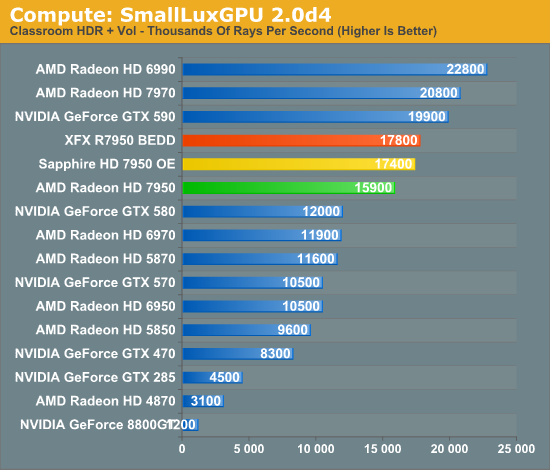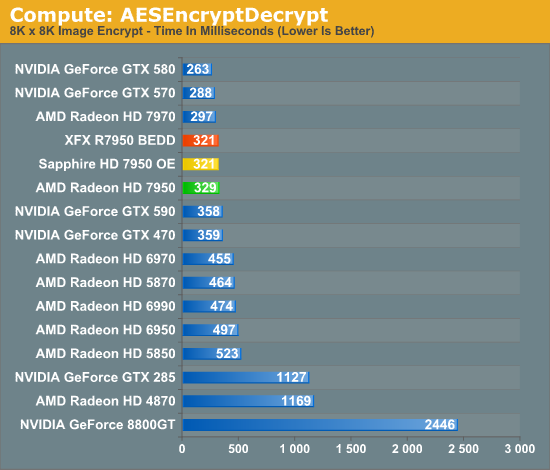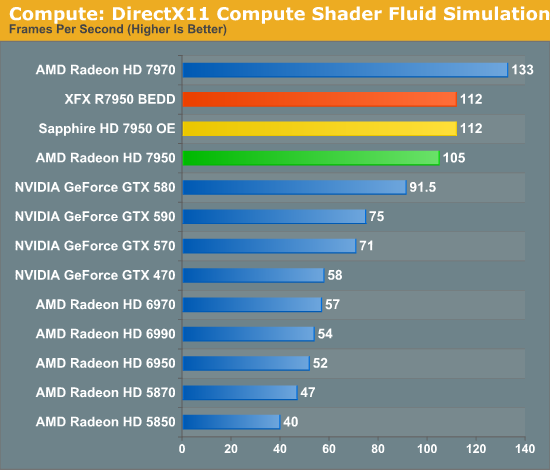AMD Radeon HD 7950 Review Feat. Sapphire & XFX: Sewing Up The High-End Market
by Ryan Smith on January 31, 2012 9:02 AM ESTCompute Performance
Moving on from our look at gaming performance, we have our customary look at compute performance. Since compute performance is by definition shader bound, the 7950 is at a bit of a disadvantage here compared to gaming performance. Whereas ROP performance scales with the core clock, shader performance is hit by both the reduction in the core clock and the disabled CU array.
Our first compute benchmark comes from Civilization V, which uses DirectCompute to decompress textures on the fly. Civ V includes a sub-benchmark that exclusively tests the speed of their texture decompression algorithm by repeatedly decompressing the textures required for one of the game’s leader scenes. Note that this is a DX11 DirectCompute benchmark.

AMD’s greatly improved compute performance continues to shine here, though in the case of Civilization V it’s largely consumed by just closing the previously large gap between the GTX 500 series and the Radeon HD 6000 series. As a result the 7950 falls ever so short of the GTX 580, while the factory overclocked Sapphire and XFX cards give the 7950 enough of a push to come within 5% of the 7970.
Our next benchmark is SmallLuxGPU, the GPU ray tracing branch of the open source LuxRender renderer. We’re now using a development build from the version 2.0 branch, and we’ve moved on to a more complex scene that hopefully will provide a greater challenge to our GPUs.

Under SmallLuxGPU the 7970 enjoyed a large lead over the GTX 580, and this continues with the 7950. Even though the 7950 is well behind the 7970—to the tune of 24%—it’s still 33% ahead of the GTX 580 and the lead only grows from there. Meanwhile the XFX and Sapphire cards can catch up to the 7970 somewhat, but as this is truly a shader-bound test, you can’t make up for the lack of shaders units on the 7950.
For our next benchmark we’re looking at AESEncryptDecrypt, an OpenCL AES encryption routine that AES encrypts/decrypts an 8K x 8K pixel square image file. The results of this benchmark are the average time to encrypt the image over a number of iterations of the AES cypher.

In spite of being a compute benchmark, AESEncryptDecrypt is not particularly sensitive to GPU performance, showcasing the impact that setup times can have. The 7950 trails the 7970 by 10%, and overclocking doesn’t change this much. Unfortunately for AMD NVIDIA is still the leader here, showing that AMD’s compute performance still has room to grow.
Finally, our last benchmark is once again looking at compute shader performance, this time through the Fluid simulation sample in the DirectX SDK. This program simulates the motion and interactions of a 16k particle fluid using a compute shader, with a choice of several different algorithms. In this case we’re using an (O)n^2 nearest neighbor method that is optimized by using shared memory to cache data.

With the compute shader fluid simulation we once again shift back into a compute task that’s much more shader-bound. The 7950 only reaches 80% of the performance of the 7970, once more proving the real impact of losing a CU array. This is still enough to handily surpass the GTX 580 however, with the 7950 taking a 15% lead.










259 Comments
View All Comments
Ryan Smith - Tuesday, January 31, 2012 - link
Thanks. It looks like the culprit is the ShareThis widget we use. I'll have our developers look at it in the morning.Ananke - Tuesday, January 31, 2012 - link
This is a wonderful but too expensive product for the targeted market niche...It will not gain user base by April to attract software developers away from Kepler...Unless NVidia really executes bad /which they will not-internal source/, AMD will be positioned worthlessly by price/performance. Anyway, I admire AMD and I use their products, just their strategy has been lost recently.gnorgel - Tuesday, January 31, 2012 - link
It seems quite pointless to me to benchmark an OC 7950 vs a stock clocked 7970.Anyone who OCs a 7950 would OC his 7970 too. The interesting question is how these 2 OCed Cards perform against each other - this decides whether the the price difference is worth it or not.
kmmatney - Tuesday, January 31, 2012 - link
The best way to get performance per dollar is at this website:http://www.videocardbenchmark.net/gpu_list.php
and sort by "Video Card Value". Using this chart, I bought an HD6850 today, to replace my HD4890 (which is also near the top of the chart). It has enogh performance for me. The performance per dollar is dominated by AMD at the moment.
kmmatney - Tuesday, January 31, 2012 - link
My comment was supposed to be a response to another comment...LuxZg - Wednesday, February 1, 2012 - link
Now all that I wish for is direct comparison between Sapphire card and PowerColor PCS+ version.. Based on techPowerUp's review PowerColor could actually have even better cooling solution (noise/heat) which would really be amazing since Sapphire is already awesome. Make my wish come true Anand! :)And thanks for great review guys and showing off what a nice job AMD & Sapphire did with their new products...
ChosenOne - Wednesday, February 1, 2012 - link
Here is the link for the comparison chart between PowerColor and Sapphire.ChosenOne - Wednesday, February 1, 2012 - link
forgot the linkLuxZg - Thursday, February 2, 2012 - link
Thanks a lot! Seems that Sapphire has the upper hand after all, in both temperatures and noise..Th-z - Wednesday, February 1, 2012 - link
What GCN is able to do in the future is yet to been seen. They need a software ecosystem to support it, like what CUDA is having. In terms of gaming, aside from lower power consumption, the price isn't very attractive. I can see 7970 command a hefty premium, but the price of 7950 would fail AMD to capture some market share. The price they're trying to undercut is a single-GPU flagship part, which also carries a premium over 570, yet 7950 isn't a flagship part.In terms of gaming performance, 7950 is close to 580, which is close to 6970, yet it costs so much higher than 6970. It would be interesting to see how AMD is going to price their VLIW4 7800 and lower parts, because from the specs, they aren't much faster than 6000 series. This time, we probably won't see good performance jump with similar price points even after a major die shrink (remember they even skipped 32 nm). And I think the unnamed NVIDIA source said they was expecting more from 7970, which I think isn't a bluff, considered their Fermi debacle.